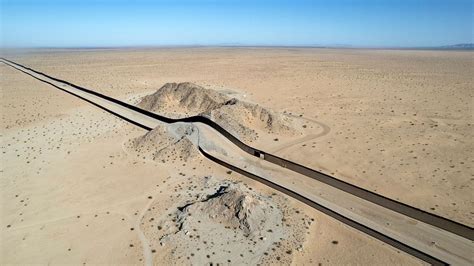
Motion-activated cameras strategically placed along the U.S.-Mexico border are offering scientists an unprecedented glimpse into the secret lives of wildlife, revealing the diverse range of species that traverse the heavily scrutinized region and providing crucial data for conservation efforts.
For years, the debate surrounding border security has largely focused on human migration and drug trafficking. However, a growing body of scientific evidence highlights the significant impact of border infrastructure on wildlife populations, their habitats, and overall biodiversity. Recognizing this, a collaborative effort between researchers and conservation organizations has led to the deployment of motion-sensing cameras along both sides of the border, from California to Texas. These cameras, triggered by movement, capture images and videos of animals as they navigate the landscape, offering valuable insights into their behavior, distribution, and challenges.
“These cameras are our eyes on the borderlands, allowing us to monitor wildlife activity in a way that wasn’t possible before,” said Dr. Paul Krausman, a wildlife biologist and one of the lead researchers on the project. “The data we collect is essential for understanding how border infrastructure affects wildlife and for developing effective conservation strategies.”
The cameras have documented a wide array of species, including iconic animals such as jaguars, ocelots, bighorn sheep, black bears, mountain lions, bobcats, deer, and various bird species. They have also captured images of more elusive creatures like ringtails, coatis, and endangered species like the Sonoran pronghorn. The data collected provides information on animal movement patterns, habitat use, breeding behavior, and interactions with border infrastructure.
One of the key findings of the camera project is the identification of critical wildlife corridors – areas that connect fragmented habitats and allow animals to move between them. These corridors are essential for maintaining genetic diversity and allowing animals to access food, water, and mates. However, border walls and other infrastructure can disrupt these corridors, isolating populations and hindering their ability to thrive.
“Border walls act as barriers, preventing animals from moving freely across the landscape,” explained Dr. Krausman. “This can lead to reduced genetic diversity, increased competition for resources, and ultimately, population declines.”
The camera data is being used to inform conservation efforts aimed at mitigating the impacts of border infrastructure on wildlife. This includes identifying priority areas for habitat restoration, advocating for wildlife-friendly border infrastructure designs, and working with border patrol agents to minimize disturbance to wildlife.
For example, researchers are using camera data to identify locations where wildlife frequently attempt to cross the border. This information can be used to guide the placement of wildlife crossings, such as underpasses or overpasses, which allow animals to safely traverse the border.
The project also highlights the importance of cross-border collaboration in conservation efforts. Wildlife populations often span international boundaries, and effective conservation requires cooperation between countries. Researchers are working with their counterparts in Mexico to share data, coordinate research efforts, and develop joint conservation strategies.
“Wildlife conservation is a shared responsibility,” said Dr. Krausman. “We need to work together with our colleagues in Mexico to protect these animals and their habitats.”
The camera project is an ongoing effort, and researchers continue to collect data and expand their monitoring network. They hope that the information they gather will help to inform border policy and ensure that the needs of wildlife are taken into account in future infrastructure development.
The use of motion-activated cameras along the U.S.-Mexico border is not without its challenges. The cameras can be expensive to purchase and maintain, and they require regular monitoring to ensure they are functioning properly. They can also be vulnerable to theft or damage. However, the benefits of the camera project far outweigh the challenges. The data collected is invaluable for understanding the impacts of border infrastructure on wildlife and for developing effective conservation strategies.
The project also serves as a reminder of the importance of considering the environmental impacts of border security measures. While border security is undoubtedly important, it is also essential to minimize the negative consequences for wildlife and their habitats. By working together, it is possible to achieve both border security and wildlife conservation.
The success of this initiative demonstrates the potential for technology to contribute to conservation efforts. Motion-activated cameras, along with other technologies such as GPS tracking and remote sensing, are providing scientists with new tools to study wildlife and protect their habitats. As technology continues to advance, it is likely to play an increasingly important role in conservation efforts around the world.
The U.S.-Mexico border is a complex and challenging environment, but it is also a place of incredible biodiversity. By using technology and collaboration, it is possible to protect this biodiversity and ensure that wildlife continues to thrive in this region for generations to come. The future of conservation along the border depends on finding solutions that balance the needs of both humans and wildlife. The camera project is a step in the right direction, providing valuable data and insights that can help to achieve this goal.
The ongoing project aims to not only monitor wildlife but also to engage the public and raise awareness about the importance of borderland conservation. Educational materials and outreach programs are being developed to inform communities about the diverse wildlife that inhabits the region and the challenges they face. By fostering a greater appreciation for the natural heritage of the borderlands, the project hopes to inspire a greater commitment to conservation.
The researchers also emphasize the need for further research to fully understand the long-term impacts of border infrastructure on wildlife populations. They plan to expand their monitoring network, conduct more detailed studies of animal movement and behavior, and investigate the genetic effects of habitat fragmentation. By continuing to gather data and deepen their understanding of the complex ecological dynamics of the borderlands, they hope to provide policymakers and conservation managers with the information they need to make informed decisions.
The findings from the camera project have significant implications for border security policy. The data demonstrates that border walls and other infrastructure can have unintended consequences for wildlife, disrupting migration patterns and isolating populations. This information can be used to inform the design and construction of border infrastructure in a way that minimizes its impact on wildlife. For example, wildlife crossings can be incorporated into border walls to allow animals to move freely between habitats.
The project also highlights the importance of considering the cumulative impacts of border infrastructure. Even seemingly small barriers can have significant effects on wildlife populations over time. By assessing the cumulative impacts of all border infrastructure, it is possible to develop a more comprehensive conservation strategy that addresses the overall effects of border security measures on wildlife.
The success of the camera project is a testament to the power of collaboration. The project brings together researchers from different institutions, conservation organizations, and government agencies. By working together, these partners have been able to achieve more than they could have accomplished individually. The collaborative model used in this project can serve as a blueprint for other conservation efforts around the world.
The U.S.-Mexico border is a region of immense ecological importance, and the wildlife that inhabits this region deserves our protection. The camera project is providing valuable information that can help to ensure that these animals continue to thrive in this region for generations to come. By working together, we can find solutions that balance the needs of both humans and wildlife and create a sustainable future for the borderlands.
The cameras have become silent sentinels, diligently recording the movements of animals, documenting the rhythms of life in a region often defined by conflict and division. They offer a counter-narrative, a reminder that the borderlands are not just a zone of contention but also a vibrant ecosystem teeming with life. The images captured by these cameras are a testament to the resilience of nature and the enduring spirit of the animals that call this region home.
The long-term vision for the camera project is to create a comprehensive monitoring network that covers the entire U.S.-Mexico border. This network would provide a continuous stream of data on wildlife populations, allowing researchers to track changes over time and identify emerging threats. The data would be used to inform conservation efforts, guide border policy, and educate the public about the importance of borderland conservation.
The project also aims to expand its outreach efforts to engage local communities in conservation. By involving local residents in data collection, monitoring, and education, the project hopes to foster a sense of stewardship for the borderlands and empower communities to protect their natural heritage.
The researchers are also exploring the use of artificial intelligence to analyze the vast amounts of data collected by the cameras. AI algorithms can be used to automatically identify animals, track their movements, and detect patterns in their behavior. This would significantly speed up the analysis process and allow researchers to focus on more complex questions.
The U.S.-Mexico border is a dynamic and ever-changing landscape, and the challenges facing wildlife in this region are constantly evolving. By continuing to monitor wildlife populations, conduct research, and collaborate with partners, the camera project can help to ensure that conservation efforts remain effective and that the needs of wildlife are taken into account in all border-related decisions.
The ultimate goal of the camera project is to create a future where the U.S.-Mexico border is a zone of both security and sustainability. A future where humans and wildlife can coexist and thrive in this region. The camera project is a small but significant step towards achieving this vision.
The data gathered is also essential for understanding the impacts of climate change on borderland wildlife. As temperatures rise and precipitation patterns shift, animals may need to move to new areas to find suitable habitats. Border walls and other infrastructure can prevent animals from moving freely, making them more vulnerable to the effects of climate change. The camera project can help to identify areas where animals are struggling to adapt to climate change and inform conservation efforts aimed at helping them survive.
The images and videos captured by the cameras are not only valuable for scientific research but also for public education. The project regularly shares its findings with the public through presentations, websites, and social media. These outreach efforts help to raise awareness about the importance of borderland conservation and inspire people to take action to protect wildlife.
The camera project is a reminder that the U.S.-Mexico border is not just a line on a map. It is a complex ecosystem that is home to a diverse array of wildlife. By working together, we can protect this ecosystem and ensure that it continues to thrive for generations to come. The camera project is a valuable tool for achieving this goal.
The efforts of the researchers and conservationists involved in this project exemplify a commitment to evidence-based conservation. By relying on scientific data to guide their actions, they are ensuring that their efforts are as effective as possible. This approach is essential for addressing the complex challenges facing wildlife in the borderlands.
The success of the camera project has inspired similar initiatives in other border regions around the world. The lessons learned from this project can be applied to other areas where border infrastructure is impacting wildlife populations. By sharing their knowledge and expertise, the researchers involved in this project are helping to promote conservation globally.
The U.S.-Mexico border is a unique and important ecosystem that deserves our attention and protection. The camera project is providing valuable information that can help to ensure that wildlife continues to thrive in this region for generations to come. By supporting this project and other conservation efforts, we can help to create a sustainable future for the borderlands.
The project’s focus extends to understanding the effects of human activity beyond just border infrastructure. The cameras also capture data on human presence, allowing researchers to assess the impact of recreational activities, agricultural practices, and other land uses on wildlife. This information is crucial for developing comprehensive conservation strategies that address all of the threats facing wildlife in the borderlands.
Furthermore, the researchers are working to integrate their findings with other data sources, such as climate models and land-use maps, to create a more holistic understanding of the borderland ecosystem. This integrated approach allows them to identify the most vulnerable areas and prioritize conservation efforts accordingly.
The ongoing success of the camera project hinges on continued funding and support. The researchers are actively seeking grants and donations to expand their monitoring network, conduct further research, and continue their outreach efforts. By investing in this project, individuals and organizations can make a tangible difference in the lives of wildlife in the U.S.-Mexico borderlands.
The story told by these borderland cameras is one of resilience, adaptation, and the enduring power of nature. It is a story that deserves to be heard, and a story that can inspire us to take action to protect the wildlife that call this region home.
Frequently Asked Questions (FAQ)
1. What is the purpose of the motion-activated cameras along the U.S.-Mexico border?
The motion-activated cameras are deployed to monitor wildlife activity along the U.S.-Mexico border. They capture images and videos of animals that cross their path, providing scientists with data on species distribution, movement patterns, habitat use, and the impact of border infrastructure on wildlife populations. As Dr. Paul Krausman stated, “These cameras are our eyes on the borderlands, allowing us to monitor wildlife activity in a way that wasn’t possible before.”
2. Which types of animals have been documented by these cameras?
The cameras have documented a wide variety of species, including jaguars, ocelots, bighorn sheep, black bears, mountain lions, bobcats, deer, ringtails, coatis, and endangered species like the Sonoran pronghorn. These recordings provide insight into the biodiversity of the border region and the challenges these animals face.
3. How does border infrastructure, such as walls, affect wildlife?
Border infrastructure, particularly walls, can act as barriers that prevent animals from moving freely across the landscape. This disruption can lead to reduced genetic diversity, increased competition for resources, and ultimately, population declines. According to Dr. Krausman, “Border walls act as barriers, preventing animals from moving freely across the landscape. This can lead to reduced genetic diversity, increased competition for resources, and ultimately, population declines.” These barriers disrupt critical wildlife corridors necessary for survival and reproduction.
4. What is being done to mitigate the negative impacts of border infrastructure on wildlife?
Researchers are using camera data to identify critical wildlife corridors and locations where animals frequently attempt to cross the border. This information is then used to guide the placement of wildlife crossings, such as underpasses or overpasses, which allow animals to safely traverse the border. Additionally, they advocate for wildlife-friendly border infrastructure designs and collaborate with border patrol agents to minimize disturbance to wildlife.
5. What is the role of cross-border collaboration in this project?
Cross-border collaboration is crucial because wildlife populations often span international boundaries. Researchers are working with their counterparts in Mexico to share data, coordinate research efforts, and develop joint conservation strategies. As Dr. Krausman emphasizes, “Wildlife conservation is a shared responsibility. We need to work together with our colleagues in Mexico to protect these animals and their habitats.” This cooperative approach is essential for effective conservation efforts.



![[Restaurant Name] Returns! Iconic Chain Revives After 30-Year Absence](https://generasitekno.com/wp-content/uploads/2025/06/unnamed-file-924-150x150.jpg)





